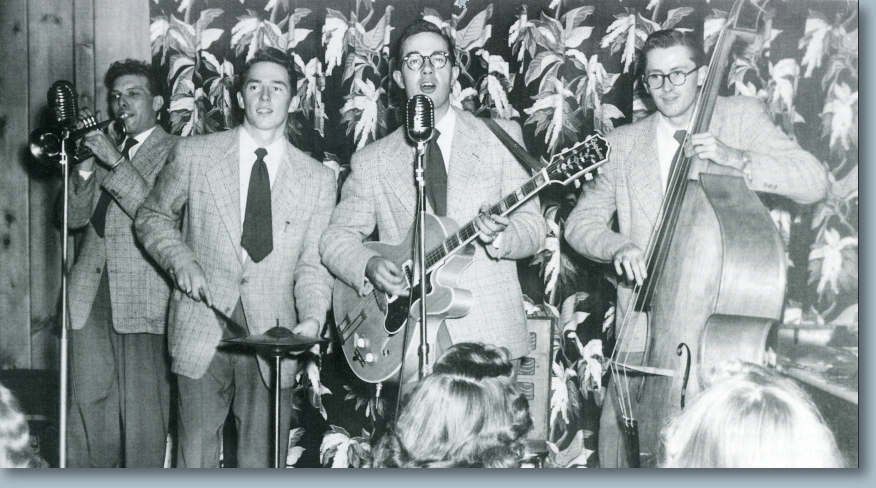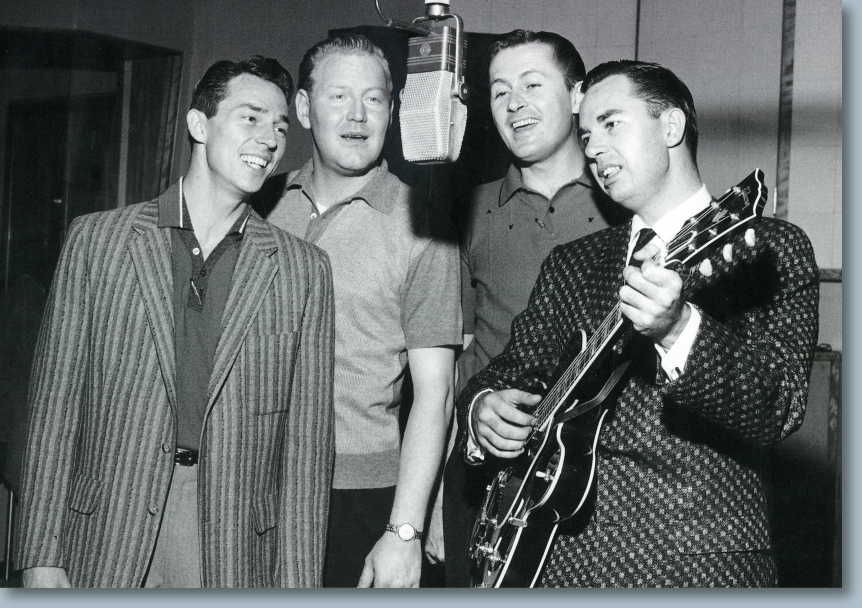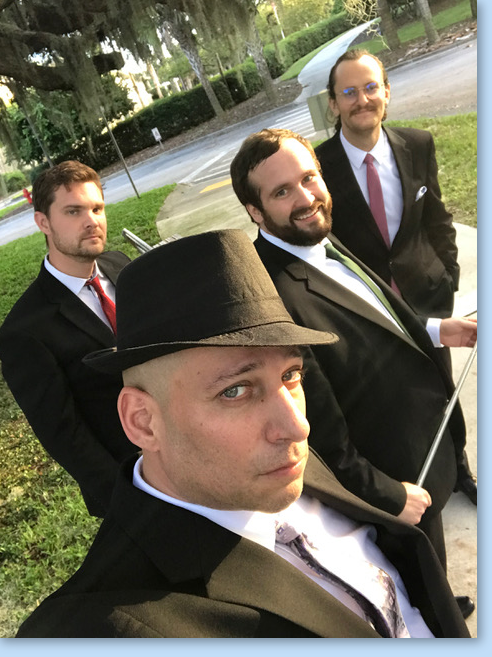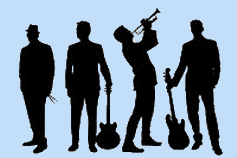The Four Freshmen Legacy
“Here We Come, Ready or Not!”
The beginning of the vocal group known as the Four Freshmen was unpredictable and haphazard at best, but the resulting incarnation was nothing short of amazing! The durability of their sound and the lasting loyalty of their fans are undeniable.
While attending their first year of college, the four young men; brothers, Don Barbour and Ross Barbour, and classmates, Hal Kratzsch and Marvin Pruitt, started singing Barbershop arrangements together. Eventually they began stretching the boundaries and breaking the mold for four-part harmony, adding their own ideas and building a new modern sound.
By the summer break, Marvin decided to go a different direction, leaving the group without their high voice. The other three went home to Columbus, Indiana where they continued to perfect their sound, singing together whenever and wherever they could. Most of their rehearsals were in the back room of the gas station where Hal was working. When they couldn’t all sing together, the Barbour brothers continued to practice their harmonies while working as tree trimmers; harmonizing while hanging in the trees. That summer, they concentrated on their sound and brought in the group’s key components: Bob Flanigan’s recognizable high voice and the instruments.
Bob Flanigan’s mother and Ross and Don’s mother were sisters, who came from a very large, very musical family. The cousins had been singing together with their family since childhood. Ross and Don knew that Bob could sing the high part, but would he do it? They contacted Bob, who was working in Florida for the summer, crating oranges. He was not sure he wanted to get involved. There was no guarantee that anything would come of it. But, he confessed, “It sounds better than packing oranges.” So, he came back to Indiana for rehearsals. Once they all began singing together, their blend was nothing short of amazing. [Bob Flanigan continued to sing with the Four Freshmen longer than any of the other original members and became the iconic voice that fans loved.]
So, after much persuading by Hal, they left their dismayed parents behind, piled into Hal’s car and ‘hit the road.’ The plan was simple, play any and all types of venues. It’s a good thing Hal was so persuasive. If not for Hal Kratzsch, the group might never have begun at all. Once they took off, they just kept going, ready or not.
In the late 1940s, vocal groups sang with big-bands or orchestras. In those days, as a rule, singers didn’t accompany themselves. While they each could play an instrument and read music, putting instrumentation together with the singing was a real challenge. They were all fans of the Stan Kenton Orchestra and took inspiration from the sound of his band. In fact, it was Stan Kenton, himself, who told the young Four Freshmen they should not sing with a band, but rather, be their own! They would have the freedom to work smaller venues and travel where they chose. It was another innovation by the upstarts, which influenced a generation of singer/musicians going forward.
Because they didn’t need to go where a big band was playing, the Four Freshmen could tour all over playing venues too small to hold an orchestra. And so, they did! [Through the years the group has performed in many interesting places: on the back of a truck, in a cave, in a basement, cruise ships, county fairs, jazz festivals, a winery and a bowling alley, to name a few]
They had a formidable band already; Don played guitar, Hal and Ross both played trumpet and Bob played trombone and bass. Hal could also play bass, when needed, but they had no percussion section. That’s when Ross began keeping time with a set of brushes and a high-hat. He used the metal end of the brushes for loud songs, and the brush end for softer sounds, often mixing the two. For a full sound, he also played trumpet on some songs with one hand and drums with the other. Later, he added a snare drum, a cymbal and a cowbell! This unique self-taught drumming style became a part of their unprecedented new sound and made them a complete band.
Of course, Ross wasn’t the only one who picked up an instrument out of necessity. Bob Flanigan had played trombone for years, but he learned to play a stand-up bass while in the Army, so he could have a place in the Army band. Apparently, the Army already had enough trombone players. During Four Freshmen shows, Bob often switched back and forth between trombone and bass within the same song. Bob would also sing a “duet” with his stand-up bass, which was a very cool jazz talent... But it was his trombone solos that attracted fans and fueled hit songs like Candy and Day by Day.
Through trial and error, Don innovated a new way of stringing his guitar which gave it a rich, full-bodied sound. This also became part of the signature sound that caused listeners to take notice.
This is Group One with Hal Kratzsch on trumpet, Ross Barbour on high-hat, Don Barbour on guitar
and Bob Flanigan on Bass.

While Don was a powerful soloist and chose his own songs to sing, he was also the primary music influencer for the group. Most of his free time was spent listening to the popular songs and he clearly had a knack for picking crowd pleasers. He suggested the songs they should learn - but all four members had to agree, or they would not do the song.
Once they had decided to learn a song, they would each begin choosing their own notes. There were no charts for their harmonies. None of the popular vocal groups of their time were singing the chords the Freshmen had in mind… They built their own arrangements and figured out the instrumentation through collaboration and experimentation. Many of those early songs never had written arrangements, they were perfected in dressing rooms and confirmed on stage.
Besides rehearsing and learning new songs, there was a lot to do when they weren’t performing. Ross planned the shows, putting together the order of songs, creating variety in each performance and timing it to meet the required set length. He would write a list and tape it to his drumhead to refer to, calling out the songs for the others. Ross was also the emcee of the shows and over time, he and Bob worked up short ‘comedy bits’ to fill in between songs. Hal worked with the booking agents to find and schedule gigs and Bob dealt with travel arrangements. Of course, in those early days, most of the travel was driving in car four cars, from town to town with a map on the lap.
By 1951, the group had really gained momentum. They had even made some records and disc jockeys were beginning to play their songs. The number of gigs increased, which was great, but that meant more traveling from town to town. By then, all the guys had wives and small children traveling on the road with them. It was not an easy life.
Hal, who had been so anxious to set out on the road, decided he was not happy traveling so much and wanted to raise his family in one place. This was a big deal! Their whole sound was based on four parts. They began to search for someone who could fill the part. As Hal made plans to leave, they were lucky to find a very talented singer/musician, Ken Errair, and they began teaching him the songs. They recorded many of their songs with Hal singing, standing close to the recorder and the others standing back a bit, so that Ken could hear his part easily. This technique seemed to work… Ken had never sung in a vocal group before, but he took to it with aplomb. In June of 1953, Hal stepped out and Ken stepped in. That was the end of the original group.
Although they didn’t realize it at the time, but they had just become what would later be called, “Group Two”. There have been over twenty different configurations of the group. Each time a new member has joined, he has brought his own set of talents and specialties to the performances. [Even though Hal recorded the first few songs with the group, his picture is not on any of the album covers. You can hear his solo voice in the early recording, Now You Know.]
Those first few years were chock-full of triumphs and tribulations. Little did they know they were laying the groundwork for musical history. Many popular vocal groups have been influenced by their vocal sound and as the fifties turned into the sixties, most of the popular singing groups who followed, such as The Beach Boys and The Beatles, played their own instruments while singing. This is something the Four Freshmen helped to usher into the modern style of performance.
This is the long-performing Group Three: Ross Barbour, Ken Albers, Bob Flanigan and Don Barbour.

The Four Freshmen have performed to faithful audiences for over seventy years, and have made fans and friends all over the world. Today, they continue to travel and perform, staying true to the sound and the dream that began in1948, playing their own instruments and singing songs from the Great American Songbook.
The Four Freshmen Society keeps its members informed about upcoming events and engagements with their website and Newsletter. They also organize an annual event for fans to gather and hear the group perform. These events, which are held in different locations each year, are always a wonderful experience for all who attend.
The Four Freshmen Music Foundation is dedicated to preserving their music and making the arrangements available to educators and to young people who are interested in learning this special sound. The Music Foundation is working with Butler University and Bowling Green State University to establish archives of Four Freshmen charts, recordings and memorabilia for preservation and viewing. The Four Freshmen Music Foundation will continue to work to keep this sound alive by bringing the music of the Four Freshmen into the lives of young singers for years to come.
The Four Freshmen legacy continues brilliantly with the current performing Freshmen:

l to r: Jake Baldwin, Bob Ferreira, Ryan Howe, Tommy Boynton


|

